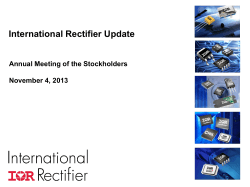
Sample Preparation Methods IM.7.P148 Low-energy Ar -polishing of FIB prepared GaN-SiC interfaces for
Sample Preparation Methods IM.7.P148 Low-energy Ar+-polishing of FIB prepared GaN-SiC interfaces for Cs-corrected STEM 1 1 1 A. Lotnyk , D. Poppitz , J. Gerlach , B. Rauschenbach 1 1 Leibniz Institute of Surface Modification, Physics, Leipzig, Germany andriy.lotnyk@iom-leipzig.de Keywords: low energy ion milling, Cs-correction, STEM For high-resolution aberration-corrected (Cs-corrected) scanning transmission electron microscopy (STEM) the quality of prepared TEM samples is crucial, because the image resolution and the quality of TEM data depends essentially on the thickness and surface quality of the TEM sample. Depending on the high voltages used for TEM work, TEM specimens should be as thin as 10 nm or less for low voltage TEM work (80 kV and lower) and they have to be as thin as 30 nm or less for medium voltage TEM work (e.g. 300 kV). Nowadays, widely used focused ion beam (FIB) preparation technique with standard FIB configuration using conventional lift-out method cannot be employed in fabrication of such thin TEM samples. The samples after FIB preparation are often too thick (more than 50 nm using even the 5 kV low voltage thinning step) for TEM studies. In addition, damage and amortization of the specimen surface during the milling process occurs. This damaged layer is a disorder of the original structure of the sample surface. To overcome these disadvantages of the FIB preparation, a low+ energy Ar -polishing post FIB lamella treatment can be applied [1]. In the present work, we focus on TEM sample preparation of GaN-SiC interfaces for analysis in Cscorrected STEM at 80 kV and 300 kV. For FIB lamellae preparation we have used standard FIB lift-out + method. Afterwards, the FIB lamellae were further prepared by a focused low-energy Ar -polishing (less than 1 keV) in a NanoMill (Fischione) low energy ion mill system. The last step was plasma cleaning of a TEM lamella for 10 min in a Gatan Solarus plasma cleaning system. A Zeiss Auriga DualBeam system was applied for FIB preparation using in situ lift-out method. TEM observations 3 were performed with a probe Cs-corrected Titan G2 60-300 microscope equipped with HAADF, BF, DF, ABF and Super-X EDX detectors as well as with GIF Quantum Gatan imaging filter. The TEM was operated at 80 kV and 300 kV. Figure 1 shows thickness measurements by means of energy filtered TEM of a porous GaN layer grown on a 6H-SiC (0001) substrate by IBA-MBE [3]. The brightness of colours in Figure 1 shows different thicknesses in the sample: the brighter the thicker. Since the brightness of the image does not change so much, the thickness of the TEM sample after NanoMill step is rather uniform. The thickness of the TEM sample at the SiC-GaN interface is in the range of 9 - 11 nm. Figure 2a) shows a HRSTEM image of the interface between GaN thin film and SiC substrate. The image in Figure 2a) was taken from an interface region of the sample shown in Figure 1. The atomic structure of the GaN-SiC interface as well as defects in the GaN thin film close to the interface is clearly resolved in Figure 2a) and Figure 2b), respectively. + Another example of successfully post-treated FIB lamella with a low-energy Ar -polishing for atomic resolution STEM investigations at medium-kV is given in Figure 3. Figure 3a) shows a bright-field STEM image of a dense GaN layer produced on a 6H-SiC (0001) substrate by IBA-MBE. Different defects at the GaN-SiC interface can be seen in the image. EFTEM thickness measurements showed that the TEM lamella has a specimen thickness of only 25 - 30 nm throughout the whole length of the lamella (not shown here). Figure 3b) gives a HAADF-HRSTEM image of the GaN-SiC interface. The atomic columns in the GaN and SiC as well as at the GaN-SiC interface are clearly resolved. The combination of FIB with focused low-energy argon ion milling in the "NanoMill" system enables to prepare routinely high quality TEM lamellae of GaN-SiC interfaces. The samples using this approach are well suited for (HR)TEM and (HR)STEM studies as well as for atomic EDX and EELS analyses at 80 kV and at 300 kV. 1. 2. 3. T. Mehrtens, S. Bley, P.V. Satyam and A. Rosenauer, Micron 43 (2012) p. 902. J. W. Gerlach, T. Ivanov, L. Neumann, Th. Höche, D. Hirsch and B. Rauschenbach, J. Appl. Phys. 111 (2012), p. 113521. The financial support of the European Union and the Free State of Saxony (LenA project) is greatly acknowledged. 305 Pt w-GaN SiC (λ= 57.5) GaN (λ= 47.2) SiC Figure 1. Thickness measurement by energy filtered TEM. From t / lambda, the thickness of a sample (t) can be calculated. a) b) w-GaN w-GaN z-GaN SiC 2 nm 2 nm Figure 2. HAADF-HRSTEM images taken at 80 kV of a) the GaN-SiC interface and b) defects and intergrowths in GaN close to the GaN-SiC interface. For STEM analysis, the FIB lamella was prepared along the a-axes of both GaN and SiC. a) b) Pt z-GaN GaN w-GaN SiC SiC 50 nm 2 nm Figure 3. a) BF-STEM image of a GaN thin film grown on a 6H-SiC (0001) substrate. b) HAADF-HRSTEM image of the GaN-SiC interface. The STEM investigations were performed at 300 kV. For STEM investigations, the TEM lamella was cut along the a-axes of both GaN and SiC. 306
© Copyright 2025





















